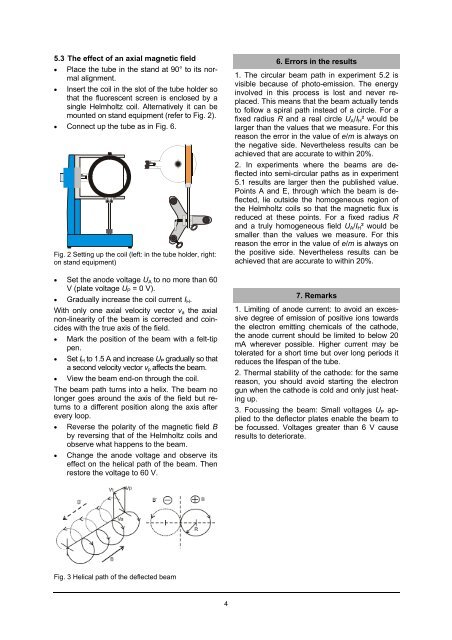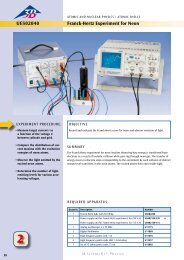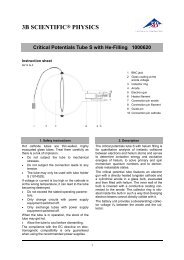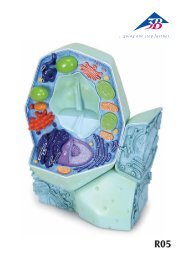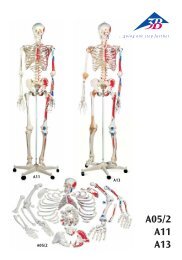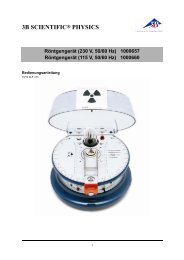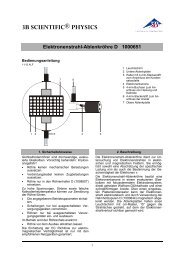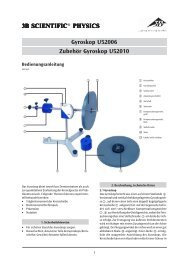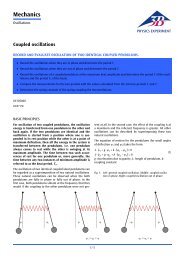You also want an ePaper? Increase the reach of your titles
YUMPU automatically turns print PDFs into web optimized ePapers that Google loves.
5.3 The effect of an axial magnetic field• Place the tube in the stand at 90° to its normalalignment.• Insert the coil in the slot of the tube holder sothat the fluorescent screen is enclosed by asingle Helmholtz coil. Alternatively it can bemounted on stand equipment (refer to Fig. 2).• Connect up the tube as in Fig. 6.-A ZFig. 2 Setting up the coil (left: in the tube holder, right:on stand equipment)• Set the anode voltage U A to no more than 60V (plate voltage U P = 0 V).• Gradually increase the coil current I H .With only one axial velocity vector v a the axialnon-linearity of the beam is corrected and coincideswith the true axis of the field.• Mark the position of the beam with a felt-tippen.• Set I H to 1.5 A and increase U P gradually so thata second velocity vector v p affects the beam.• View the beam end-on through the coil.The beam path turns into a helix. The beam nolonger goes around the axis of the field but returnsto a different position along the axis afterevery loop.• Reverse the polarity of the magnetic field Bby reversing that of the Helmholtz coils andobserve what happens to the beam.• Change the anode voltage and observe itseffect on the helical path of the beam. Thenrestore the voltage to 60 V.-6. Errors in the results1. The circular beam path in experiment 5.2 isvisible because of photo-emission. The energyinvolved in this process is lost and never replaced.This means that the beam actually tendsto follow a spiral path instead of a circle. For afixed radius R and a real circle U A /I H ² would belarger than the values that we measure. For thisreason the error in the value of e/m is always onthe negative side. Nevertheless results can beachieved that are accurate to within 20%.2. In experiments where the beams are deflectedinto semi-circular paths as in experiment5.1 results are larger then the published value.Points A and E, through which the beam is deflected,lie outside the homogeneous region ofthe Helmholtz coils so that the magnetic flux isreduced at these points. For a fixed radius Rand a truly homogeneous field U A /I H ² would besmaller than the values we measure. For thisreason the error in the value of e/m is always onthe positive side. Nevertheless results can beachieved that are accurate to within 20%.7. Remarks1. Limiting of anode current: to avoid an excessivedegree of emission of positive ions towardsthe electron emitting chemicals of the cathode,the anode current should be limited to below 20mA wherever possible. Higher current may betolerated for a short time but over long periods itreduces the lifespan of the tube.2. Thermal stability of the cathode: for the samereason, you should avoid starting the electrongun when the cathode is cold and only just heatingup.3. Focussing the beam: Small voltages U P appliedto the deflector plates enable the beam tobe focussed. Voltages greater than 6 V causeresults to deteriorate.Fig. 3 Helical path of the deflected beam4


